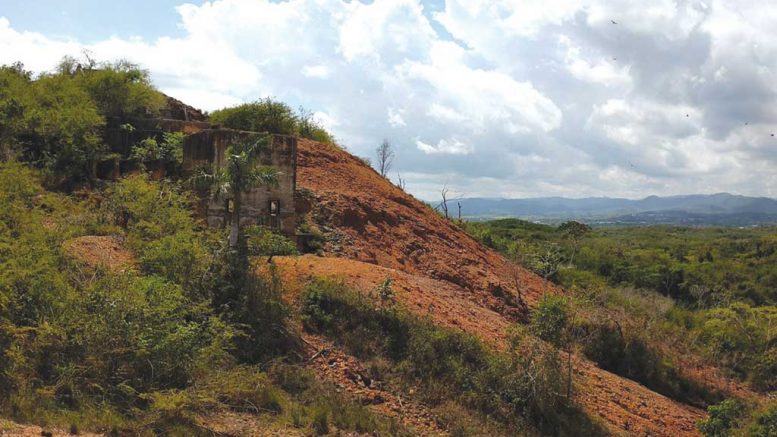In late April, privately held Millbrook Minerals became the first copper-zinc explorer to sign an International Economic Association (IEA) contract with Cuban state mining company GeoMinera. The document permits Millbrook to explore and drill its 317 sq. km Los Pasos polymetallic project, which covers Cuba’s entire Los Pasos belt.
“Back in the nineties you signed a joint venture right away,” Millbrook president Doug Hunter says in a telephone interview with The Northern Miner. “You don’t do that anymore. It’s more like an option joint-venture arrangement. You go through stages.”
Millbrook’s IEA will last five years with the option for the company to extend it another year and a half. The company will finish an environmental baseline study during its first year and a feasibility study before reaching a production decision. If it reaches production, the permit will be issued to a joint venture between Millbrook and GeoMinera, with 51% Cuban ownership.
Los Pasos consists of three former copper-zinc-gold-silver producers and 16 exploration targets. According to Millbrook vice-president of corporate development Alastair McIntyre, the three former producers — San Fernando, Santa Rosa and Antonio — are the company’s focus.

Los Pasos consists of three former copper-zinc-gold-silver producers and 16 exploration targets. Credit: Millbrook Minerals.
“We want to build out on these projects that were former producers with the idea to quickly elevate them to an economic scenario,” McIntyre says. “The ultimate goal is to bring this public when we feel we’ve added some significant value to the project.”
The San Fernando mine produced copper and zinc intermittently from 1827 to the late 1950s, when it shut down during the Cuban Revolution. It produced 200,000 tonnes copper-zinc ore from 10 underground levels accessed by a 173-metre shaft. As part of its due diligence, Millbrook took five samples from San Fernando that returned an average 6.6 grams gold per tonne and 298 grams silver.
Through compiling historic data, Millbrook will soon table a National Instrument 43-101 compliant resource estimate for San Fernando. The project has 240,000 inferred tonnes grading 2.04% copper, 3.6% zinc and 28.7 grams silver for 10.64 million lb. copper, 18.79 million lb. zinc and 220,000 oz. silver. The company says there was not enough data to estimate gold content.
“By our standards today it was a small operation and only mined to relatively shallow depths,” Hunter says. “But some of the massive sulphide there was some of the nicest stuff I’ve ever seen.”
Santa Rosa lies 9 km east of San Fernando. The site has two adits 15 metres deep. The Cuban government ran an exploration program at Santa Rosa in 2011, taking channel samples, conducting an induced-polarization survey and drilling holes as deep as 50 metres below surface. The project remains open in all directions.

A rock sample from Millbrook Minerals’ Los Pasos property in Cuba. Credit: Millbrook Minerals.
Highlights included 6 metres from 14.5 metres downhole grading 2.96 grams gold, 43.66 grams silver, 0.55% copper and 0.55% zinc, as well as 1 metre from 20 metres downhole at 7.89 grams gold and 3 grams silver.
The company’s Antonio deposit, 20 km southeast of Santa Rosa, has mineralization traced to 190 metres below surface, which remains open at depth. Like San Fernando, it was active in the 1950s before shutting down during the Revolution. Based on historical data, Millbrook calculated two resource estimates for Antonio.
In an open-pit scenario, the project has 2.25 million inferred tonnes grading 1.58% copper, 2.51% zinc and 16.5 grams silver for 78.38 million lb. copper, 124.49 million lb. zinc and 220,000 oz. silver. In an underground scenario the project contains 910,000 inferred tonnes grading 1.49% copper, 2.3% zinc and 9.7 grams silver for 29.77 million lb. copper, 45.99 million lb. zinc and 280,000 oz. silver.
McIntyre says Millbrook is in “fundraising mode” for a $3-million, first-year exploration program it hopes to begin later in the third quarter. The first phase of exploration would consist of aeromagnetic surveys of the entire belt to re-evaluate the “known occurrences.” Millbrook would follow up the flyovers with basic mapping, sampling and drilling.
For its second exploration phase, Millbrook is targeting a $7-million program that would culminate in a preliminary economic assessment.
“The potential is huge there and always has been, because there’s been relatively little work done,” Hunter says.
Millbrook is one of three notable foreign mining companies active in Cuba, along with Trafigura’s Emincar joint venture with the government of Cuba and Sherritt International (TSX: S).
Emincar is a joint venture between Trafigura and the government of Cuba to develop the Castellanos zinc-lead mine in northwest Cuba. Trafigura finished building Castellanos in late 2017. It expects the mine to reach full capacity this year, producing 100,000 tonnes zinc and 50,000 tonnes lead per year over 22 years. Trafigura never signed an IEA, and skipped instead to the joint-venture stage.
Sherritt’s Moa mine in eastern Cuba produced 15,762 tonnes finished nickel and 1,801 tonnes finished cobalt. The mine has been active since 1994. In 2018, Sherritt expects to produce as much as 32,500 tonnes finished nickel and 3,800 tonnes finished cobalt from Moa.
Seeking more foreign investment, the Cuban government developed its IEA system in 2014.
“Nickel’s very important, but they want to develop other resources,” Hunter says. “And the copper-zinc and gold potential is very high in Cuba.”


Be the first to comment on "Millbrook pens exploration contract with Cuban gov’t"